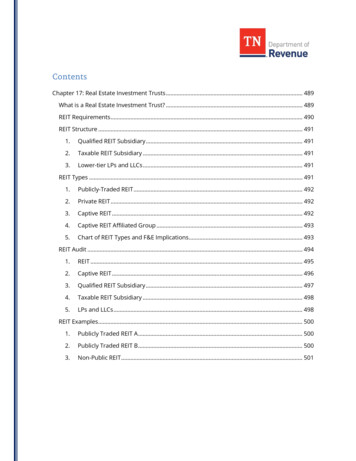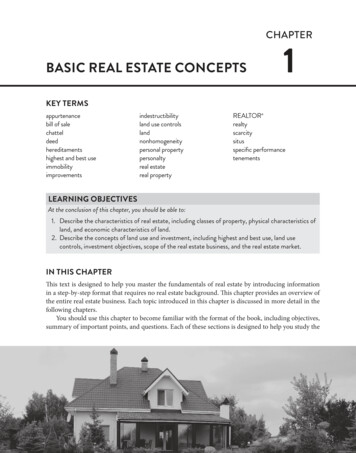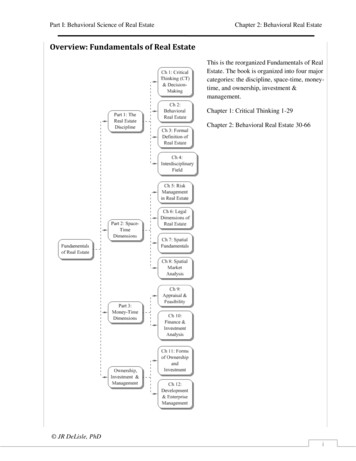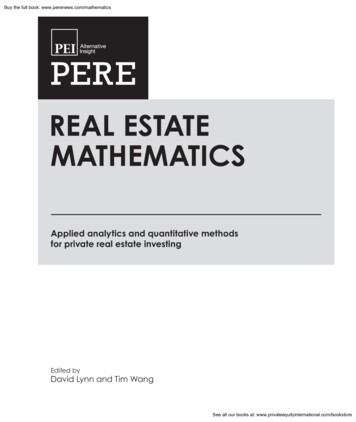
Transcription
2Rights in Real EstateReal Estate as PropertyReal Versus Personal PropertyRegulation of Real Property InterestsREAL ESTATE AS PROPERTYLandReal estatePropertyReal property rightsWater rightsA simple definition of real estate is that it is air, water, land, and everythingaffixed to the land. Real estate in the United States may be owned privately byindividuals and private entities or publicly by government entities. Privateownership rights in this country are not absolute. The government can imposetaxes and restrictions on private ownership rights, and it can take privateproperty away altogether. In addition, other private parties can exert their rightsand interests on one's real property. A bank, for example, can take a property ifthe owner fails to pay a mortgage. A neighbor can claim the right to walk acrossone's property whether the owner likes it or not, provided he or she has done sofor a certain number of years.In attempting to define real estate, it is essential to understand what rights andinterests parties have in a parcel of real estate. And to understand real estaterights and interests, one must first recognize the distinctions between: Landland and real estatereal estate and propertyreal property and personal propertyThe legal concept of land encompasses the surface area of the eartheverything beneath the surface of the earthextending downward to its centerall natural things permanently attached to the earththe air above the surface of the earth extendingoutward to infinity.Land, therefore, includes minerals beneath the earth's surface, water on or belowthe earth's surface, and the air above the surface. In addition, land includes all16 Principles of Real Estate Practice
plants attached to the ground or in the ground, such as trees and grass. A parcel,or tract, of land is a portion of land delineated by boundaries.Physical characteristics. Land has three unique physicalcharacteristics: immobility, indestructibility, and heterogeneity.Land is immobile, since a parcel of land cannot be moved from one site toanother. In other words, the geographical location of a tract of land is fixed andcannot be changed. One can transport portions of the land such as mined coal,dirt, or cut plants. However, as soon as such elements are detached from theland, they are no longer considered land.Land is indestructible in the sense that one would have to remove a segment ofthe planet all the way to the core in order to destroy it. Even then, the portionextending upward to infinity would remain. For the same reason, land isconsidered to be permanent.Land is non-homogeneous, since no two parcels of land are exactly the same.Admittedly, two adjacent parcels may be very similar and have the sameeconomic value. However, they are inherently different because each parcel hasa unique location.Real estateThe legal concept of real estate encompasses: landall man-made structures that are"permanently" attached to the landReal estate therefore includes, in addition to land, such things as fences, streets,buildings, wells, sewers, sidewalks and piers. Such man-made structures attachedto the land are called improvements. The phrase "permanently attached" refersprimarily to one's intention in attaching the item. Obviously, very few if anymanmade structures can be permanently attached to the land in the literal sense.But if a person constructs a house with the intention of creating a permanentdwelling, the house is considered real estate. By contrast, if a camper affixes atent to the land with the intention of moving it to another camp in a week, the tentwould not be considered real estate.Chapter 2: Rights in Real Estate 17
Exhibit 2.1 The Legal Concept of Land and Real EstatePropertyIn common understanding, property is something that is owned by someone. Acar is the property of Bill Brown if Bill Brown owns the car. If the item is notowned, it is not property. For example, if a car is abandoned and left to rust in thedesert, the car is no longer property, since no one claims ownership. Similarly,the planet Jupiter is not property, since no one owns it.From a more technical standpoint, property is not only the item that is ownedbut also a set of rights to the item enjoyed by the owner. These rights arecommonly known as the "bundle of rights."Exhibit 2.2 The Bundle of RightsIn owning property, one has the right to possess and use it as the law allows. Theowner has the right to transfer ownership of the item (sell, rent, donate, assign, orbequeath). The owner may also encumber the item by mortgaging it as collateralfor debt. Finally, the owner has the right to exclude others from use of the item.In the example of the car, when Bill Brown bought the car, the car became his18 Principles of Real Estate Practice
property: he owned the car itself. At the same time, he also acquired the legalrights to transfer, use, encumber, exclude, and possess the car.Classifications of property. Our legal system recognizes two classifications ofproperty: real property and personal property. Real property is ownership ofreal estate and the bundle of rights associated with owning the real estate.Personal property is ownership of anything which is not real estate, and therights associated with owning the personal property item. Items of personalproperty are also called chattels or personalty.Note: since all real estate in the United States is owned by some person,private organization, or government entity, all real estate in the country is realproperty. Given that fact, this text will follow the customary practice of usingthe two terms interchangeably and synonymously.Tangible versus intangible property. Real and personal property may be furthercategorized as tangible or intangible property. Tangible property is physical,visible, and material. Intangible property is abstract, having no physical existencein itself, other than as evidence of one's ownership interest.Exhibit 2.3 Tangible vs. Intangible PropertyTangibleReal Propertyall typesPersonalPropertyboat, car, jewelryIntangiblestock certificate,contract, patentAll real estate, by its physical nature, is tangible property. Personal propertymay be tangible or intangible. Boats, jewelry, coins, appliances, computers, andart work are examples of tangible personal property. Stocks, copyrights, bonds,trademarks, patents, franchises, and listing agreements are examples ofintangible personal property.Real property rights Real property rights consist of the bundle of rights associated with owning aparcel of real estate. Foremost of these rights is the right of possession.The right to use a property refers to the right to use it in certain ways, such asmining, cultivating, landscaping, razing, and building on the property. The rightis subject to the limitations of local zoning and the legality of the use. One'sright to use may not infringe on the rights of others to use and enjoy theirproperty. For example, an owner may be restricted from constructing a largepond on her property if in fact the pond would pose flooding and drainagehazards to the next door neighbor.The right to transfer interests in the property includes the right to sell, bequeath,lease, donate, or assign ownership interests. An owner may transfer certainindividual rights to the property without transferring total ownership. Also, onemay transfer ownership while retaining individual interests. For example, aChapter 2: Rights in Real Estate 19
person may sell mineral rights without selling the right of possession. On theother hand, the owner may convey all rights to the property except the mineralrights.While all rights are transferrable, the owner can only transfer what the owner infact possesses. A property seller, for example, cannot sell water rights if thereare no water rights attached to the property.The right to encumber the property essentially means the right to mortgage theproperty as collateral for debt. There may be restrictions to this right, such as aspouse's right to limit the degree to which a homestead may be mortgaged.The right to exclude gives the property owner the legal right to keep others offthe property and to prosecute trespassers.The bundle of real property rights also applies separately to the individualcomponents of real estate: the air, the surface, and the subsurface. An owner can,for example, transfer subsurface rights without transferring air rights. Similarly,an owner can rent air space without encumbering surface or subsurface rights.This might occur in a city where adjoining building owners want to construct awalkway over a third owner's lot. Such owners would have to acquire the airrights for the walkway. If the city wants to construct a subway through theowner's subsurface, the city has to obtain the subsurface rights to do so.An ordinary lease is a common example of the transfer of a portion of one'sbundle of rights. The owner relinquishes the right to possess portions of thesurface, perhaps a building, in return for rent. The tenant enjoys the rights topossess and use the building over the term of the lease, after which these rightsrevert to the landlord. During the lease term, the tenant has no rights to theproperty's subsurface or airspace other than what the building occupies. Further,the tenant does not enjoy any of the other rights in the bundle of rights: hecannot encumber the property or transfer it. To a limited degree, the tenant mayexclude persons from the property, but he may not exclude the legal owner.Surface rights. Surface rights apply to the real estate contained within thesurface boundaries of the parcel. This includes the ground, all natural thingsaffixed to the ground, and all improvements. Surface rights also include waterrights.Air rights. Air rights apply to the space above the surface boundaries of theparcel, as delineated by imaginary vertical lines extended to infinity. Since theadvent of aviation, air rights have been curtailed to allow aircraft to fly overone's property, provided the overflights do not interfere with the owner's use andenjoyment of the property. The issue of violation of air rights for the benefit ofair transportation is an ongoing battle between airlines, airports, and nearbyproperty owners.Subsurface rights. Subsurface rights apply to land beneath the surface of thereal estate parcel extending from its surface boundaries downward to the center20 Principles of Real Estate Practice
of the earth. Notable subsurface rights are the rights to extract mineral and gasdeposits and subsurface water from the water table.Water rightsWater rights basically concern the rights to own and use water found in lakes,streams, rivers, and the ocean. In addition, they determine where parcelboundaries can be fixed with respect to adjoining bodies of water. What waterrights does an owner of a property that contains or adjoins a body of waterenjoy? The answer depends on three variables: whether the state controls the waterwhether the water is movingwhether the water is navigableDoctrine of Prior Appropriation. Since water is a resource necessary forsurvival, some states -- particularly those where water is scarce -- have taken thelegal position that the state owns and controls all bodies of water. Called theDoctrine of Prior Appropriation, this position requires that property ownersobtain permits for use of water. If a proposed usage is reasonable and beneficial,the state will grant a permit which, over time, can attach to the property of thepermit holder. If a state does not operate under prior appropriation, it operatesunder the common law doctrines of littoral rights and riparian rights.Littoral rights. Littoral rights concern properties abutting bodies of water thatare not moving, such as lakes and seas. Owners of properties abutting anavigable, non-moving body of water enjoy the littoral right of use, but do notown the water nor the land beneath the water. Ownership extends to the highwater mark of the body of water.Exhibit 2.4 Littoral RightsThe legal premise underlying the definition of littoral rights is that a lake or sea isa navigable body of water, therefore, public property owned by the state. Bycontrast, a body of water entirely contained within the boundaries of an owner'sproperty is not navigable. In such a case, the owner would own the water as wellas unrestricted rights of usage.Chapter 2: Rights in Real Estate 21
Littoral rights attach to the property. When the property is sold, the littoralrights transfer with the property to the new owner.Riparian rights. Riparian rights concern properties abutting moving water suchas streams and rivers. If a property abuts a stream or river, the owner's riparianrights are determined by whether the water is navigable or not navigable. If theproperty abuts a non-navigable stream, the owner enjoys unrestricted use of thewater and owns the land beneath the stream to the stream's midpoint. If thewaterway in question is navigable, the waterway is considered to be a publiceasement. In such a case, the owner's property extends to the water's edge asopposed to the midpoint of the waterway. The state owns the land beneath thewater.Exhibit 2.5 Riparian RightsOne's riparian rights to use flowing water are subject to the conditions that: the usage is reasonable and does not infringe on the riparianrights of other owners downstreamthe usage does not pollute the waterthe usage does not impede or alter the course of the water flow.Like littoral rights, riparian rights attach to the property.22 Principles of Real Estate Practice
REAL VERSUS PERSONALPROPERTYFixturesDifferentiation criteriaTrade fixturesEmblementsFactory-built housingConversionIn conveying real property, it is vitally important to recognize the distinctionsbetween personal property and the real property that is to be conveyed.Confusion can arise because items of property may be either personal propertyor real property, depending on circumstances.The primary criterion for distinguishing real from personal property is whetherthe item is permanently attached to the land or to structures attached to the land.For example, a tree growing in one's yard is an item of real property. However,when the owner cuts the tree down, it becomes personal property. Similarly, aswimming pool pump on a shelf in the owner's garage is personal property. Whenit is installed with the rest of the pool, it becomes real property.While the "attachment" criterion is pivotal in distinguishing between real andpersonal property, there are other tests to be applied. In addition, theattachment rule is subject to exceptions.FixturesA personal property item that has been converted to real property byattachment to real estate is called a fixture. Typical examples are chandeliers,toilets, water pumps, septic tanks, and window shutters.The owner of real property inherently owns all fixtures belonging to the realproperty. When the owner sells the real property, the buyer acquires rights to allfixtures. Fixtures not included in the sale must be itemized and excluded in thesale contract.DifferentiationcriteriaIn the event that the attachment criterion is insufficient to determine whetheran article of property is real or personal, a court may apply one or more ofthe following additional criteria.Intention. One's original intention can override the test of movability indetermining whether an item is a fixture or not. If someone attached an item toreal property, yet intended to remove it after a period of time, the article may bedeemed personal property. If a person intended an article to be a fixture, eventhough the item is easily removable, the article may be deemed a fixture.For example, an apartment renter installs an alarm system, fully intending toremove the system upon lease expiration. Here, the alarm system would beconsidered personal property.Adaptation. If an item is uniquely adapted to the property, or the property iscustom-designed to accommodate the item, it may be deemed real propertyChapter 2: Rights in Real Estate 23
whether the item is easily removable or not. House keys, a garbage compactor,and a removable door screen are examples.Functionality. If an item is vital to the operation of the building, it may bedeemed a fixture, even though perhaps easily removable. Window-unit airconditioners and detachable solar panels are possible examples.Relationship of parties. If a tenant installs a fixture in order to conduct business,the fixture may be considered a trade fixture, which is the tenant's personalproperty.Sale or lease contract provisions. In a sale or lease transaction, the listing of anitem in the contract as a personal property item or a fixture overrides all otherconsiderations. Unless otherwise stated as exceptions, all fixtures are included inthe sale. For example, if a sale contract stipulates that the carpeting is notincluded in the sale, it becomes a personal property item. If the carpeting is notmentioned, it goes with the property, since it is attached to the floor of thebuilding.Trade fixturesTrade fixtures, or chattel fixtures, are items of a tenant's personal property thatthe tenant has temporarily affixed to a landlord's real property in order toconduct business. Trade fixtures may be detached and removed before or uponsurrender of the leased premises. Should the tenant fail to remove a trade fixture,it may become the property of the landlord through accession. Thereafter, thefixture is considered real property.Examples of trade fixtures include a grocer's food freezers, a merchant's clothesracks, a tavern owner's bar, a dairy's milking machines, and a printer's printingpress.EmblementsGrowing plants, including agricultural crops, may be either real property orpersonal property. Plants and crops that grow naturally without requiringanyone's labor or machinery are considered real property.Plants and crops requiring human intervention and labor are called emblements.Emblements, despite their attachment to land, are considered personal property.If an emblement is owned by a tenant farmer, the tenant has the right to theharvested crop whether the tenant's lease is active or expired. If the tenant grewthe crop, it is his or her personal property, and the landlord cannot take it.Factory-builthousingFactory-built housing consists of dwelling units constructed off-site andtransported to and assembled on a building site. The category also includesreadily moveable housing of the type that can be relocated from place to place,once known by the term mobile home. The National Manufactured HousingConstruction and Safety Standards Act of 1976 defined the types of factory-builthousing and retired the mobile home designation. Manufactured housing isfactory-built housing that conforms to HUD standards. Factory-built housingmay be considered real property or personal property, depending on whether it ispermanently affixed to the ground, and according to state law. Real estatepractitioners should understand the local laws before selling any kind of factorybuilt housing.24 Principles of Real Estate Practice
ConversionThe classification of an item of property as real or personal is not necessarilyfixed. The classification may be changed by the process of conversion.Severance is the conversion of real property to personal property by detaching itfrom the real estate, such as by cutting down a tree, detaching a door from ashed, or removing an antenna from a roof. Affixing, or attachment, is the act ofconverting personal property to real property by attaching it to the real estate,such as by assembling a pile of bricks into a barbecue pit, or constructing a boatdock from wood planks.Exhibit 2.6 Real Property vs. Personal PropertyReal Propertylandfixturesattachmentsconversions by affixingPersonal Propertytrade fixturesemblementsconversions by severancePROPERTY INTERESTSAreas of regulationFederal regulationState regulationLocal regulationJudicial regulationAlthough the Constitution guarantees private ownership of real estate, laws andregulations at every level of government qualify and limit individual realproperty ownership and the bundle of rights associated with it.Areas ofregulationGovernment entities regulate the following aspects of real property interests: the bundle of rights: possession,usage, transfer, encumbering andexclusionlegal egulation takes the form of federal and state laws and regulations; county andlocal ordinances and codes; and court decisions in the judicial system.Federal regulationIn regulating real property rights, the federal government is primarily concernedwith broad standards of real property usage, natural disaster, land description, anddiscrimination.Chapter 2: Rights in Real Estate 25
Federal agencies such as the Federal Housing Administration promote andregulate home ownership. The Environmental Protection Agency establishesprotective usage restrictions and guidelines for dealing with hazardous materialsand other environmental concerns. Federal flood insurance legislation requirescertain homeowners to obtain flood insurance policies. Federal laws such as theFederal Fair Housing Act of 1968 prohibit discrimination in housing based onrace, religion, color, or national origin. Such laws as the Americans withDisabilities Act prescribe design and accessibility standards.The federal government does not levy real estate taxes.State regulationState governments are the primary regulatory entities of the real estate business.State governments establish real estate license laws and qualifications. Inaddition, state governments have established real estate commissions toadminister license laws and oversee activities of licensees.State governments also exert regional influence in the usage andenvironmental control of real estate within the state. Relevant state lawsmight include laws relating to flood zones, waste disposal, drainage control,shore preservation, and pollution standards.States also play a role in defining how real property may be owned,transferred, encumbered, and inherited. For example, in some states amortgaged property becomes the legal property of the lender until themortgage loan is paid.States have the power to levy real estate taxes but generally pass this power tolocal government.Local regulationCounty and local government regulation focuses on land use control, control ofimprovements, and taxation. Land use regulations and ordinances control howall property within the jurisdiction may be developed, improved, demolished,and managed. County and local governments have the power to zone land, takeover land for the public good, issue building permits, and establish the rules forall development projects.County and local governments, along with school districts and other localjurisdictions, have the power to levy real estate taxes.JudicialregulationThe judicial system exerts an influence on real estate ownership and usethrough decisions based on case law and common law, as distinguished fromstatutory law. Case law consists of decisions based on judicial precedent.Common law is the collective body of law deriving from custom and generallyaccepted practice in society.26 Principles of Real Estate Practice
Exhibit 2.7 Regulation of Real Property InterestsConstitutionEstablishes absolute right of private ownership of real estateProhibits federal government from levying real property taxesLawsCreate, regulate real estate-related agenciesProhibit discriminationCreate standards for legal descriptions of real estateEstablish environmental standards for all propertyEstablish standards for protecting interests of handicapped peopleAgenciesEstablish mortgage lending standardsEstablish housing construction standardsEstablish environmental standardsConstitutionMay establish right to levy tax; or may delegate right to counties andmunicipalitiesLawsRegulate real estate licensingEstablish broad usage standardsDefine, qualify ownership rightsAgenciesRegulate practitioners, administer real estate license lawsLawsCreate and enforce real estate taxationControl land usage over specific parcels of landCommon lawRegulates real estate ownership and usage according to customary andaccepted practicesCase lawRegulates real estate ownership and usage according to prior court decisionsFederalStateLocalCourtsChapter 2: Rights in Real Estate 27
2Rights and Interests in Real EstateSnapshot ReviewREAL ESTATEAS PROPERTY Constitution guarantees private ownership of real estate; ownership rightsnot absolute; others may exert claims against one's propertyLand surface, all natural things attached to it, subsurface, and air above thesurface; unique aspects: immobile, indestructible, heterogeneousReal estate land plus all permanently attached man-made structures, calledimprovementsProperty something that is owned by someone and the associated rights of ownership the bundle of rights: possession, use, transfer, exclusion, andencumbrance property is real or personal, tangible or intangibleReal property rights any of the bundle of rights, applied to airspace (air rights), surface (surfacerights), and subsurface (subsurface rights)Water rights Doctrine of Prior Appropriation: state controls water usage; grants usagepermits littoral rights: abutting property owners own land to high water mark; mayuse, but state owns underlying land riparian rights: if navigable, abutting property owners own land to water'sedge; may use, but state owns underlying land; if not navigable, ownerowns land to midpoint of waterwayREAL VS PERSONALPROPERTY an item may be real or personal property depending on the "attachment"criterion and other circumstancesFixtures real property converted from personal property by attachment to real estateDifferentiation criteria intention; adaptation; functionality; relationship of parties; contractprovisionsTrade fixtures personal property items temporarily attached to real estate in order toconduct business; to be removed at some pointEmblements plants or crops considered personal property since human intervention isnecessary for planting, harvestingFactory-built housing housing pre-built off-site; includes mobile homes; real or personaldepending on attachment to landConversion transforming real to personal property through severance, or personal to realproperty through affixingFederal regulation grants overall rights of ownership; controls broad usage standards,discriminationState regulation governs the real estate business; sets regional usage standardsLocal regulation levies real estate taxes; controls specific usageJudicial regulation applies case law and common law to disputesREGULATION OF REALPROPERTY INTERESTS28 Principles of Real Estate Practice
Chapter 2: Rights in Real Estate 17 plants attached to the ground or in the ground, such as trees and grass. A parcel, or tract, of land is a portion of land delineated by boundaries.











